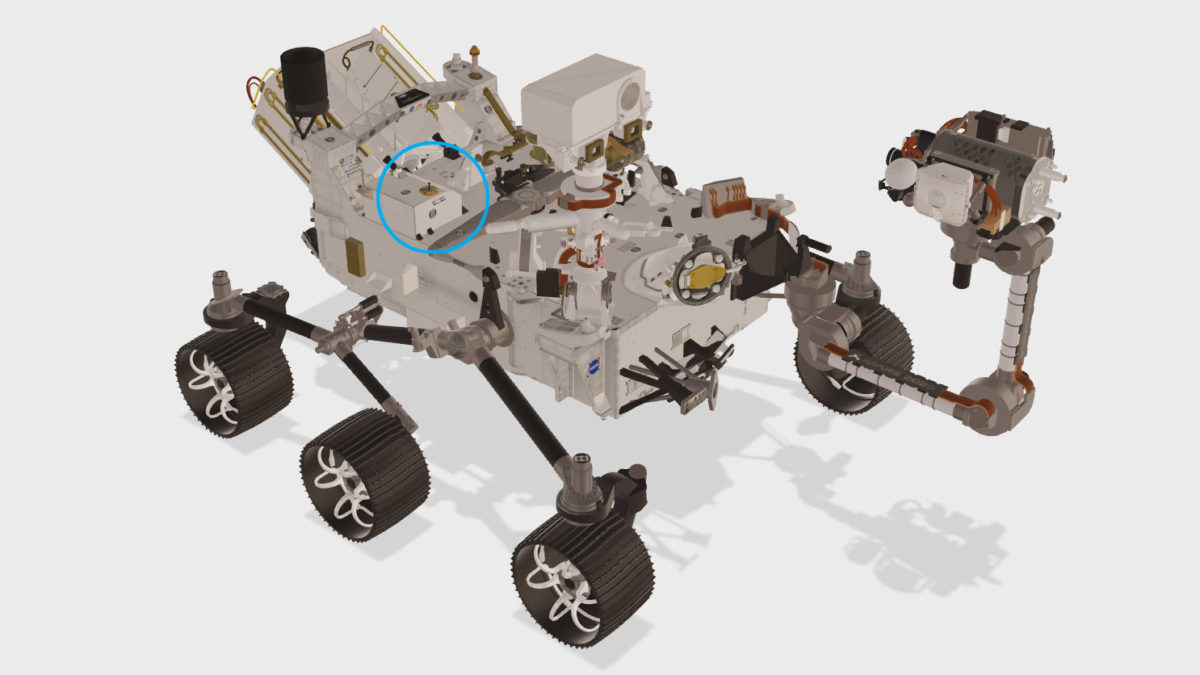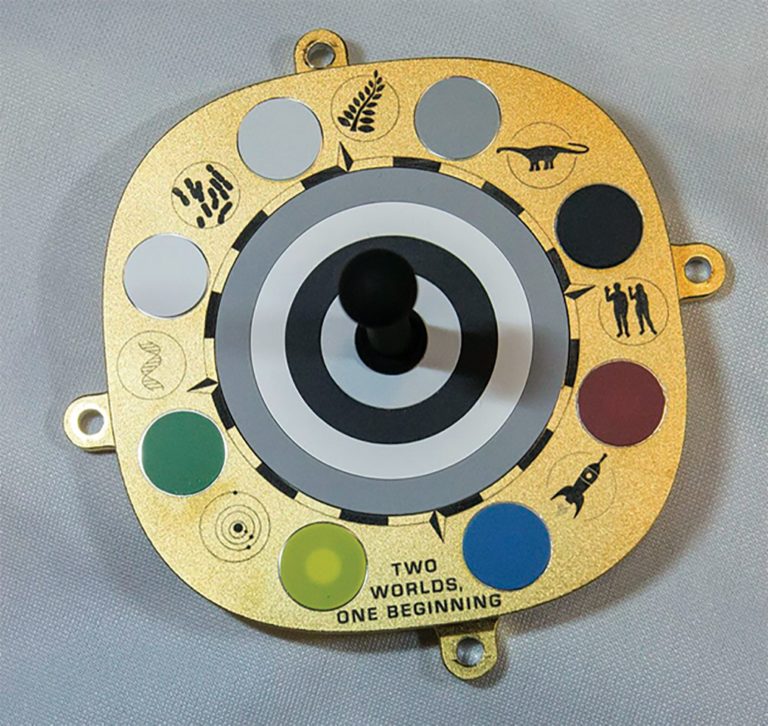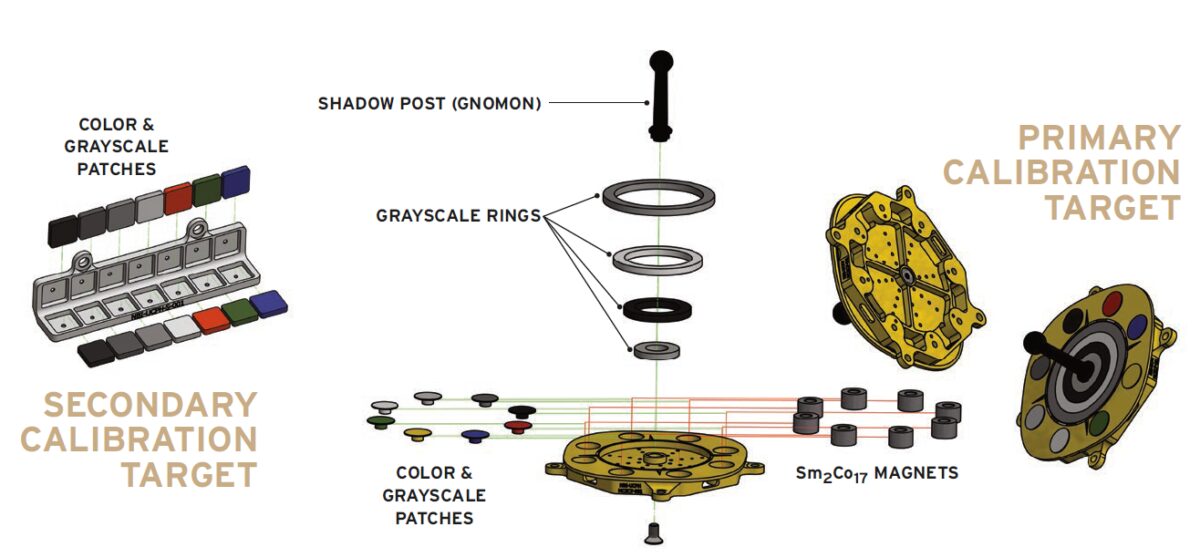Calibrating Mars
Two Colorful Calibration Targets Will Help Scientists Measure Martian Scenes
In July, NASA’s Perseverance rover launched from Kennedy Space Center in Florida, carrying to Mars the hopes, dreams, and efforts of thousands of engineers and scientists. The 1-ton rover will land in Jezero crater this February. Sometime around 3 to 4 billion years ago, Jezero was filled with a lake fed by 2 rivers on the northwest side. Mars likely had an environment at the time that could have supported life. Perseverance will explore Jezero’s river delta for signs of ancient life, attempting to answer one of the biggest questions in science: are we alone?
As the rover travels the delta, it will collect samples with a robotic coring drill and seal them into small tubes. Later this decade, NASA and the European Space Agency are planning missions that will bring the samples back to Earth. Perseverance’s onboard cameras help rover drivers plan the route and avoid dangerous hazards. Two scientific cameras on the rover’s mast also help scientists study the composition of nearby rocks and soil, providing critical context for when the samples are studied in Earth laboratories many years from now.
Those 2 scientific cameras are known as Mastcam-Z. They sit about 2 meters off the surface—about eye level for a professional basketball player—and are based on the Mastcam cameras aboard NASA’s highly successful Curiosity rover. They are upgraded with zoom capabilities (hence the “Z”).
The cameras have filters that allow them to see how bright rocks and soils and other features of interest look across different wavelengths of light, including some in the infrared and ultraviolet that human eyes can’t see. Scientists can tell a lot about a scene based on how bright it is at different wavelengths. However, there’s a problem: just like on Earth, the brightness of scenes on Mars varies depending on the time of day, the time of year, and how much dust is in the atmosphere. How can we account for those changing conditions? We use calibration targets—objects of known brightness and color that will tell us how the Sun and dust are affecting our measurements.

How Calibration Works
The primary and secondary Mastcam-Z calibration targets are mounted
behind the rover’s mast atop a small box that houses the electronics for
the rover’s pyro firing systems. Both are small enough to fit in the
palm of your hand and collectively weigh just 118 grams (4.2 ounces).
Whenever Mastcam-Z takes an image of the Martian terrain, we can tell it
to image the calibration targets too. Since we already measured how
these targets reflect various wavelengths of light on Earth, imaging
them on Mars will tell us how to adjust our readings.
We’ll use the primary target the most, but since the secondary is located nearby but in a different spot that gets shadowed about half the time, we can use images of it to understand how Sun exposure and dust accumulation are affecting the primary target. That’s right—our calibration target has a calibration target!
Every NASA surface mission ever sent to Mars has had a calibration target. Since scientists image these targets many times during a mission, a little extra thought gets put into their appearance. The Planetary Society helped design the calibration targets for the Spirit and Opportunity rovers, and since it is an official education and outreach partner for the Mastcam-Z instrument, it helped with Perseverance’s design too.

The Primary Target
The primary target measures 10 centimeters (4 inches) across. It has an aluminum base with thin silver and gold coatings on top to give it an artistic appearance and to enable laser etching of additional embellishments. Along the outside of the target are 8 circular patches with colors that span the range of sensitivity of the Mastcam-Z cameras. Underneath each is a strong magnet that should repel most of the Martian dust from its center. This is based on similar magnets used on the Spirit, Opportunity, Phoenix, and Curiosity missions.
Inside that are 4 gray-to-black rings that match 4 of the circles on the periphery. These rings, like the grayscales on a photographer’s test chart, provide the main calibration information used by the camera team.
In the middle of the rings is a post called a “gnomon,” which is the name for the part of a sundial that casts a shadow. The grayscale rings surround the gnomon so that brightness can be measured in both sunlit parts of the rings and parts of the rings that are shadowed by the gnomon. The shadows on Mars are not black but reddish because of sunlight scattered by the dusty atmosphere. (Similarly, shadows on Earth are distinctly blueish because of sunlight scattered in our blue sky.) Surrounding the middle rings is a compass rose with points aligned along the rover’s X and Y directional axes. Using the gnomon’s shadow on the compass rose, you can determine either the direction the rover is pointing or the local time as long as you know the other!
The target also contains laser-engraved graphics, a motto, and an inspirational message. NASA calls these embellishments “festooning”; they don’t serve a direct engineering or scientific purpose, but they’re meaningful nonetheless. They have artistic value, they help communicate Perseverance’s goals and historical context to the public, and they offer a fun and educational way to connect to the mission.
The Motto
Like Spirit, Opportunity, and Curiosity, Perseverance’s primary calibration target has a motto. The original inspiration for Spirit and Opportunity was the gnomon since sundials often have mottos associated with beginnings, endings, or the passage of time.
The Spirit and Opportunity motto was “Two Worlds, One Sun,” and you can learn more about the calibration target for those missions in the January/February 2004 issue of The Planetary Report. Curiosity’s motto is “To Mars To Explore.” Perseverance’s motto, “Two Worlds, One Beginning,” echoes the Spirit and Opportunity motto and evokes the idea of Earth and Mars growing out of the same initial cloud of gas and dust that formed our solar system. Both planets had similar starting conditions but evolved into very different worlds.
We chose the Eurostile font for its clean forms that are free of sharp points and excessive detail. This also serves as a nod to science-fiction fans like many of us on the team since Eurostile appears in movies like 2001: A Space Odyssey as well as the Star Trek TV and movie series.
The Graphics
Seven icons, which the Mastcam-Z team calls “vignettes,” fill the space between the colored calibration circles and depict the evolution of life, from the formation of our solar system to spaceflight.
- Mercury, Venus, Earth, and Mars orbiting the sun: This symbolizes the formation of the solar system and the steady revolutions of our planets. The positions of Mercury, Venus, and Earth are shown for the time of the launch window in July 2020, while Mars is at its approximate position for the time of the landing in February 2021.
- DNA strand: This symbolizes the emergence of life on Earth. Perhaps Perseverance will help us learn that life formed on Mars around the same time.
- Cyanobacteria: This symbolizes the early proliferation of microorganisms on Earth and possibly Mars.
- Fern: This symbolizes green plants spreading across Earth.
- Dinosaur: An apatosaurus symbolizes the great diversity of life on Earth.
- Humans: This vignette echoes the image of humans placed on plaques aboard the Pioneer spacecraft in the 1970s, which will eventually reach interstellar space. A similar image is encoded on the Voyager golden records, which are already in interstellar space. On Pioneer, only the man is waving, and on Voyager, the woman is waving. We decided to make both people wave.
- Rocket: The rocket is traveling from Earth (the blue dot) to Mars (the red dot). We chose a stylistic rocket because the realistic version looked a little too much like a missile. Additionally, the stylized version is linked to science fiction that was popular at the dawn of the Space Age, which inspired many early scientists and engineers to pursue the exploration of other worlds.

Inspirational Message
The Spirit, Opportunity, and Curiosity calibration targets carried
inspirational messages printed on the edges of the target that were not
visible from onboard cameras. These messages were meant to be read by
future astronauts or other travelers to Mars. Perseverance’s target has a
message, but it’s shorter since our target base is thinner to save
weight. It reads: “Are we alone? We came here to look for signs of
life, and to collect samples of Mars for study on Earth. To those who
follow, we wish a safe journey and the joy of discovery.”
The phrase “joy of discovery” then repeats in Mandarin, Hindi, Spanish, and Arabic. Together with English, these are the 5 most-spoken languages on Earth. “Joy of discovery” was also the final phrase on the Spirit, Opportunity, and Curiosity targets, connecting Perseverance to its predecessors.

Secondary Target
The secondary calibration target is smaller and simpler, measuring just 8 centimeters (3 inches) long. It repeats the color patterns from the primary target with the exception of yellow because of limitations on the size of the target. The patterns are repeated both horizontally and vertically; the vertical patterns will accumulate less dust and give us yet another measure of how the Martian environment is affecting the calibration targets.
Eyes Open on Mars
When Mastcam-Z first opens its eyes on Mars, one of the first things we’ll do is image the targets while they are as dust-free as possible, giving us a baseline from which we can monitor changes. Later, as the rover explores Jezero crater, pictures of the targets will beam back to Earth alongside gorgeous panoramas of the Martian landscape; close-up images of rocks, soils, layers, and other features that formed in an ancient river; and more.
Did life once exist on Mars? This is a big question that can only be answered with countless small steps spanning decades. Perseverance, the next step, relies on thousands of parts, processes, and people to do its job. We’re honored to be part of the group that made these calibration targets possible and by the role we’re playing in answering that ultimate question posed on the rover for future Martian visitors: are we alone?
About the authors
Kjartan Kinch is a Mastcam-Z coinvestigator based at the Niels Bohr Institute of the University of Copenhagen in Copenhagen, Denmark. He led the design, manufacture, and testing of the Mastcam-Z calibration targets. He loves maps.
Mark Hilverda is a digital specialist for The Planetary Society. He is a designer and geoscientist who loves space, art, and web development. Working with the Mastcam-Z team, he created the art for the vignettes on the calibration target.
Morten Bo Madsen is a Mastcam-Z coinvestigator based at the Niels Bohr Institute of the University of Copenhagen in Copenhagen, Denmark. He has participated in all of NASA’s rover missions and led the design, manufacture, and testing of camera calibration targets for NASA’s Phoenix lander. He loves music, Mars landscapes, and working with science.
Jim Bell is the Mastcam-Z principal investigator, and he served as president of The Planetary Society’s board of directors from 2008 to 2020. He teaches at Arizona State University and has been having fun using and designing Mars calibration targets since NASA’s 1997 Pathfinder mission.
The Planetary Report • December Solstice
Help advance space science and exploration! Become a member of The Planetary Society and you'll receive the full PDF and print versions of The Planetary Report.


 Explore Worlds
Explore Worlds Find Life
Find Life Defend Earth
Defend Earth


